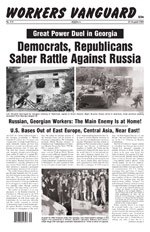
Bolshevik Policy on Self-Determination (Quote of the Week) Following the 1917 Bolshevik Revolution in Russia and the outbreak of the Civil War, the social-democratic Mensheviks set up an “independent” bourgeois state in Georgia under the aegis of first German and then British imperialism. Bloodily suppressing the Georgian Bolsheviks, the Mensheviks used “independence” as a smokescreen for collaboration with the imperialists in their drive to overthrow Soviet rule in Russia and assist the counterrevolutionary White armies. Entering Georgia in early 1921 in defense of the revolution, the Red Army rapidly swept away the discredited Mensheviks and their imperialist patrons. As laid out by Bolshevik leader Leon Trotsky in his 1922 work, Between Red and White, Soviet power laid the basis for transcending interethnic conflicts in the Caucasus. We do not only recognise, but we also give full support to the principle of self-determination, wherever it is directed against feudal, capitalist and imperialist states. But wherever the fiction of self-determination, in the hands of the bourgeoisie, becomes a weapon directed against the proletarian revolution, we have no occasion to treat this fiction differently from the other “principles” of democracy perverted by capitalism…. The epoch of Tsarism was characterised by barbarous nationalist pogroms in the Caucasus, where the Armenian-Tartar butcheries were periodical events. Those sanguinary outbursts under the iron rule of Tsarism were the expression of centuries of internecine struggles of the Trans-Caucasian peoples. The epoch of so-called democracy gave to the nationalist struggle a much more pronounced and organised character. In the beginning nationalist armies were formed, which were hostile to each other, and which often attacked each other. The attempt to create a bourgeois federal democratic Trans-Caucasian Republic proved a dismal failure. The Federation fell to pieces five weeks after its inception. A few months later the “democratic” neighbours were quite openly at war with each other. This fact alone settles the question: for if democracy was as incapable as Tsarism of creating conditions for a peaceful cohabitation of the Trans-Caucasian peoples, it was evidently imperative to adopt other methods. The Soviet power alone has established peace and national intercourse between them. At the elections to the Soviets, the Baku and Tiflis workers elect a Tartar, an Armenian, or a Georgian, irrespective of their nationality. In Trans-Caucasia, the Moslem, Armenian, Georgian, and Russian Red regiments live side by side. They are imbued with the conviction that they are one army, and no power on earth will make them move against one another. On the other hand, they will defend Soviet Trans-Caucasia against any and every external foe. The national pacification of Trans-Caucasia, which has been achieved by the Soviet revolution, is in itself a fact of enormous political and cultural significance. In it is expressed a real live internationalism, which we can safely put against the empty pacifist discourses of the heroes of the Second International, which are but a supplement to the chauvinist practices of its national sections. —Leon Trotsky, Between Red and White (1922)
|
|
||||||||||||||||||||||||||||||||||||||||||||||||||


